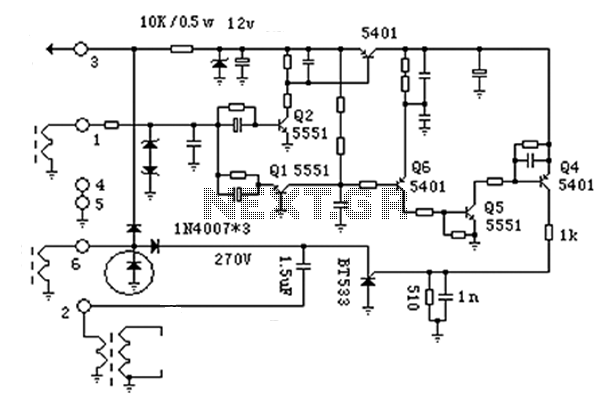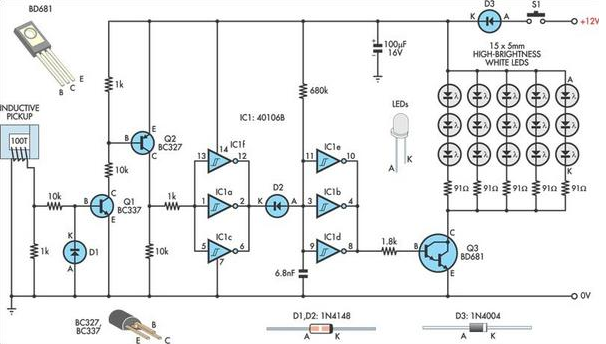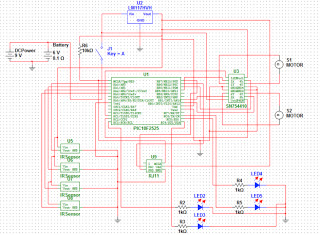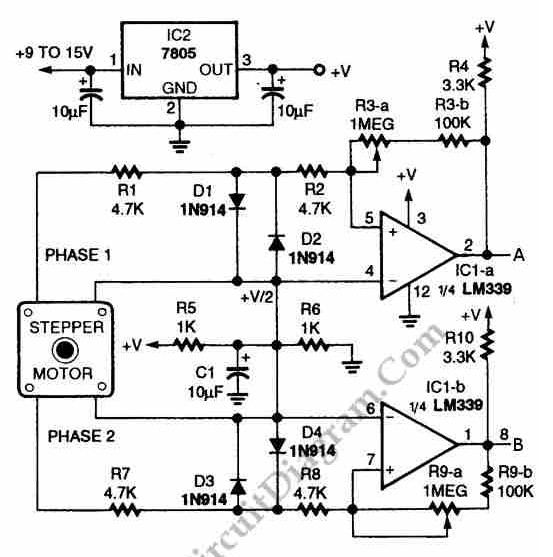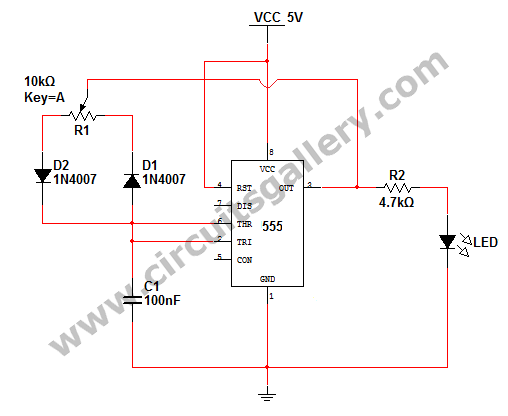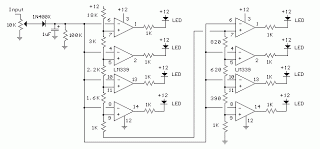
Using LED lights do motor phase failure protection
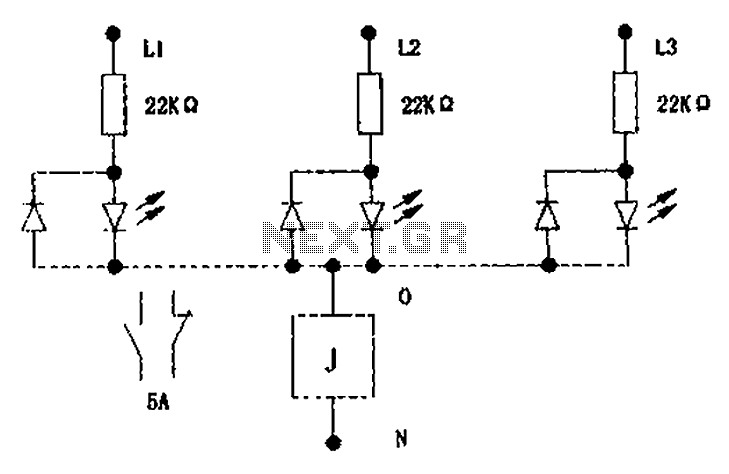
The circuit illustrated below activates a small relay (J) when there is an imbalance in any one phase of a three-phase circuit. This relay triggers an external control contact, which immediately disconnects the power supply to the main circuit AC contactor coil, thereby providing protection for the motor phase. The components used include 5mm bright white light-emitting diodes (or yellow-green and red, corresponding to the three phases A, B, and C), a 1N4001 silicon diode, and a 2W 22k ohm resistor. The small relay can be either an HH52P-L plug-driven type or a Chint JZX-22F rated for 5A AC 220V. An adjusting resistor is included to set the forward current of the light-emitting diode to approximately 15mA, with a forward voltage drop of about 3.5V for normal illumination. The primary consideration is to ensure that the small relay operates within a current range of 10 to 20mA. When there is a break in the star point balance of the three-phase circuit, the voltage at the zero point rises to 190V. This voltage, when applied across the small relay J, exceeds the minimum pull-in voltage, causing it to actuate and illuminate the red light-emitting diode. The components are cost-effective, and it is possible to add a small buzzer between the zero point and the neutral (N) or at the relay J terminals, allowing for a larger external alarm. This setup enables a simultaneous alarm through sound, light, and motion.
The described circuit is designed to monitor the balance of a three-phase power supply and provide protection against phase failure. It employs a small relay (J) that is sensitive to voltage changes indicative of an imbalance. When the voltage at the zero point exceeds the specified threshold (190V), the relay is energized. This energizing action can be visualized through the illumination of a red LED, which serves as a visual indicator of the fault condition.
The inclusion of a 1N4001 diode ensures that the circuit is protected from reverse voltage, which could damage sensitive components. The 2W 22k ohm resistor is utilized to limit the current flowing through the light-emitting diodes, ensuring their longevity and proper operation. The adjustment of the resistor allows for fine-tuning of the forward current, which is critical for ensuring that the light-emitting diodes operate efficiently without exceeding their rated specifications.
The choice of relays, such as the HH52P-L or the Chint JZX-22F, provides flexibility in component selection based on availability and specific application requirements. Both relays are capable of handling the 5A AC load, making them suitable for controlling the main circuit AC contactor coil.
Furthermore, the option to incorporate a buzzer or an external alarm enhances the functionality of the circuit. This feature is particularly useful in industrial or commercial environments where immediate attention is required in the event of a phase failure. The combination of auditory and visual alarms ensures that personnel are alerted promptly, allowing for quick intervention to prevent potential damage to equipment.
Overall, this circuit design is a robust solution for monitoring three-phase systems, providing essential protection and alerting mechanisms to maintain operational integrity and safety. Circuit as shown below, when the three-phase circuit in any one phase, star point balance is broken, small relay J is energized, an external control contact action, immediately cut off the main circuit AC contactor coil power supply, the motor phase protection. Components using 5mm bright white light-emitting diodes (or yellow-green and red, correspond exactly to ABC three-phase), 1N4001 silicon diode, 2W22k resistance, small relay option HH52P-L plug-driven or used for light 5A AC220V Chint JZX-22F. Adjusting resistor, the light-emitting diode forward current around 15mA, the forward voltage drop of about 3.5V, to normal light.
The main thing is to meet the current small relay, generally between 10 ~ 20mA. When the three-phase circuit in any one phase, star point balance is broken, position to rise to 190V voltage zero zero point. The 0:00 is vacant, not in contact with any of the zero line. The 190V voltage is applied to both ends of a small relay J, pull-in voltage greater than the minimum, and the action, on top of a red light-emitting diode light itself.
These small components, cheap. Between 0:00 and N points, or small relay J ends, you can also add a small buzzer, or through the contact leads, large external alarm. Sound, light, motion, three things at the same time the alarm.
The described circuit is designed to monitor the balance of a three-phase power supply and provide protection against phase failure. It employs a small relay (J) that is sensitive to voltage changes indicative of an imbalance. When the voltage at the zero point exceeds the specified threshold (190V), the relay is energized. This energizing action can be visualized through the illumination of a red LED, which serves as a visual indicator of the fault condition.
The inclusion of a 1N4001 diode ensures that the circuit is protected from reverse voltage, which could damage sensitive components. The 2W 22k ohm resistor is utilized to limit the current flowing through the light-emitting diodes, ensuring their longevity and proper operation. The adjustment of the resistor allows for fine-tuning of the forward current, which is critical for ensuring that the light-emitting diodes operate efficiently without exceeding their rated specifications.
The choice of relays, such as the HH52P-L or the Chint JZX-22F, provides flexibility in component selection based on availability and specific application requirements. Both relays are capable of handling the 5A AC load, making them suitable for controlling the main circuit AC contactor coil.
Furthermore, the option to incorporate a buzzer or an external alarm enhances the functionality of the circuit. This feature is particularly useful in industrial or commercial environments where immediate attention is required in the event of a phase failure. The combination of auditory and visual alarms ensures that personnel are alerted promptly, allowing for quick intervention to prevent potential damage to equipment.
Overall, this circuit design is a robust solution for monitoring three-phase systems, providing essential protection and alerting mechanisms to maintain operational integrity and safety. Circuit as shown below, when the three-phase circuit in any one phase, star point balance is broken, small relay J is energized, an external control contact action, immediately cut off the main circuit AC contactor coil power supply, the motor phase protection. Components using 5mm bright white light-emitting diodes (or yellow-green and red, correspond exactly to ABC three-phase), 1N4001 silicon diode, 2W22k resistance, small relay option HH52P-L plug-driven or used for light 5A AC220V Chint JZX-22F. Adjusting resistor, the light-emitting diode forward current around 15mA, the forward voltage drop of about 3.5V, to normal light.
The main thing is to meet the current small relay, generally between 10 ~ 20mA. When the three-phase circuit in any one phase, star point balance is broken, position to rise to 190V voltage zero zero point. The 0:00 is vacant, not in contact with any of the zero line. The 190V voltage is applied to both ends of a small relay J, pull-in voltage greater than the minimum, and the action, on top of a red light-emitting diode light itself.
These small components, cheap. Between 0:00 and N points, or small relay J ends, you can also add a small buzzer, or through the contact leads, large external alarm. Sound, light, motion, three things at the same time the alarm.
